Outdoor palms can develop brown leaf tips if there is a rapid change in weather, if the palm is growing rapidly and replacing old leaves, if it is lacking sunlight, underwatered or overfertilized. Water outdoor palms regularly and remove old leaves to tidy up the plant.
This article will explore the top reasons why outdoor palm leaves develop brown tips and how to solve each one.
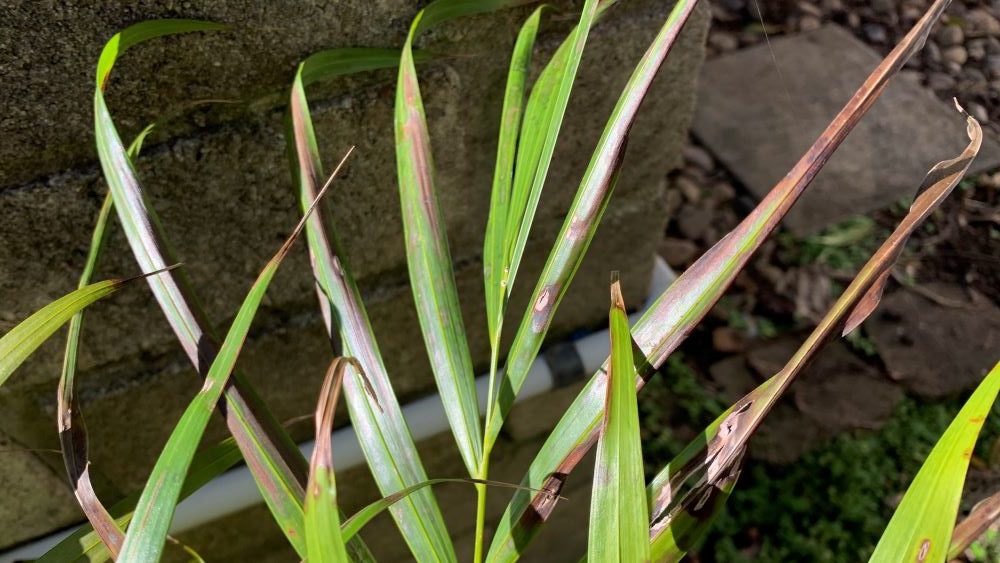
6 Reasons why outdoor palm leaves get brown tips
Here are the top reasons why outdoor palms can get brown tips and how to solve each one.
1. Rapid changes in weather
Outdoor palms can be affected by rapid or extreme changes in weather conditions. When the temperature changes rapidly from cold to hot or hot to cold it can shock the plant.
Outdoor palms particularly hate when the weather gets very cold or frosts occur. This can damage the leaves causing the tips to turn brown.
Sudden increases in temperature can also cause the leaves to turn brown on the tips. If the palm dries out too much or gets sunburnt it can develop yellow or brown patches.

Sunburn will not harm the plant if it is watered well. These damaged leaves can be trimmed off to tidy up the plant or left on after frosts or the harsh sunny weather has passed.
2. Not enough sunlight
Outdoor palms that are not getting enough sunlight can develop brown tips. Palms love a warm, tropical climate with plenty of sunlight so their leaves can photosynthesize.
Palms that are not getting enough sun can start to turn yellow and then brown on the tips. Plant palms in a position that gets lots of early sun. If you live in a hot and dry climate, make sure they have protection from the afternoon sun.
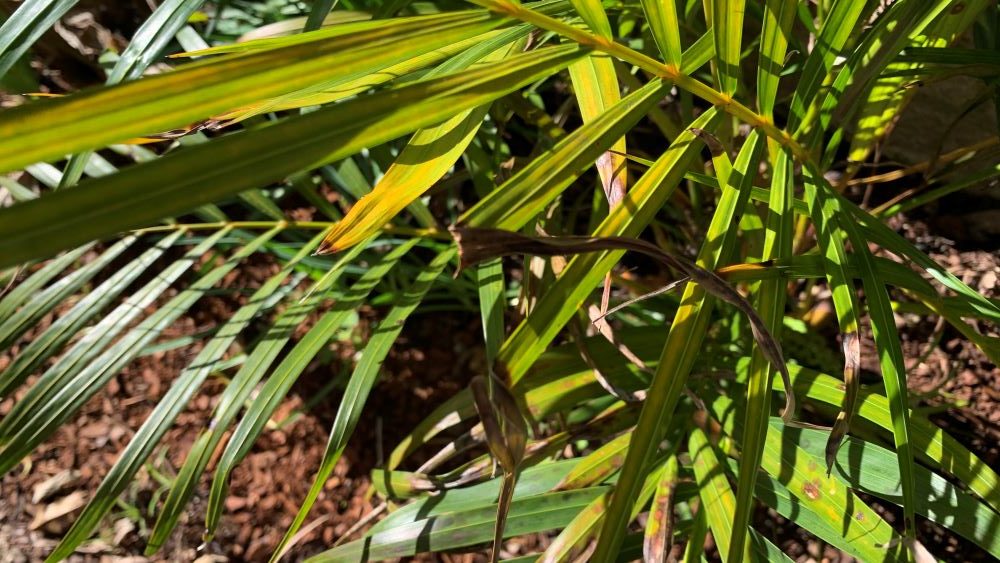
Plant them among other palms so they can shade each other in the afternoon.
3. Old leaves
The old leaves on outdoor palms will eventually develop brown leaf tips. These old leaves will be closer to the base of the plant and will be gradually replaced by new leaves grown from the center or crown of the plant.
Old leaves around the base of the plant can be trimmed off with sharp, clean secateurs. The plant will quickly replace them with new leaves if it is getting enough water and nutrients.
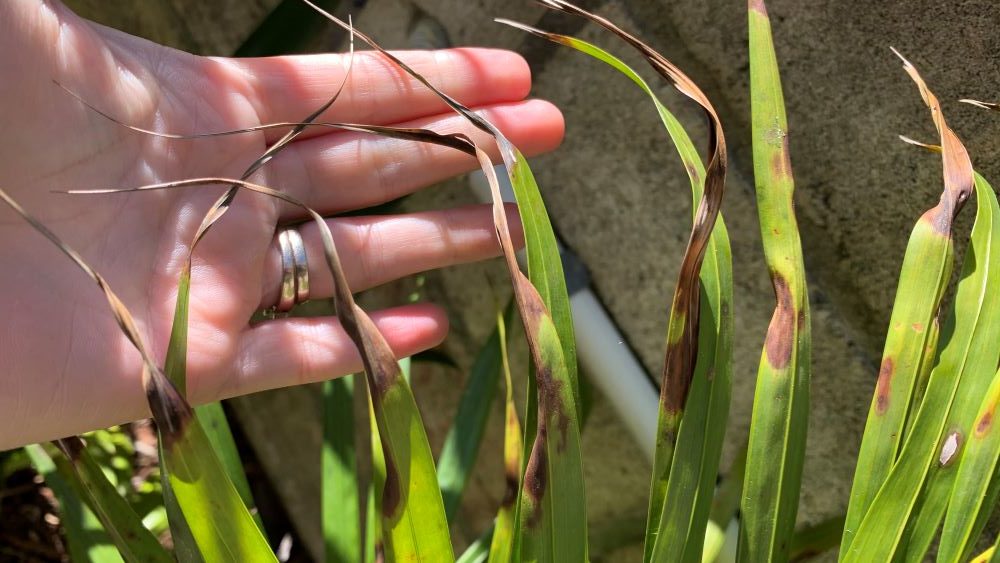
4. Too much fertilizer
Outdoor palms can develop brown leaf tips if they are given too much fertilizer. Too much nitrogen, potassium or phosphorus can cause fertilizer burn which can damage the tips.
To avoid fertilizer burn feed outdoor palms with a gentle organic fertilizer like pelleted chicken manure.
They will release slowly and are less likely to burn the roots. Sprinkle 1-2 handfuls of pelleted chicken manure around the base of the palm and water it in well.
5. Salty or chlorinated water
Plants that are watered by ‘hard’ treated water can develop brown leaf tips. Some water sources can contain lots of salt, chlorine or other elements that can build up in the leaves over time.
If you suspect your water is highly salty or chlorinated the plants will benefit from being watered with rainwater.
To remove the excess chlorine from the water, fill a bucket with your tap water and leave it outdoors for 24 hours. Lots of the chlorine will naturally break down and evaporate reducing the amount in the water.
6. Too much water
Overwatering can cause the leaf tips of outdoor palms to turn brown. Too much water can wash away nitrogen from the soil causing the leaves to turn yellow then brown.
Too much water can also cause the roots of the palm to rot. Fungal growth can damage the root tips and stop it from absorbing the water and nutrients it needs.
Avoid overwatering your palm and plant it in well-draining soil. Mix organic matter through the soil if you are planting your palm into heavy clay.
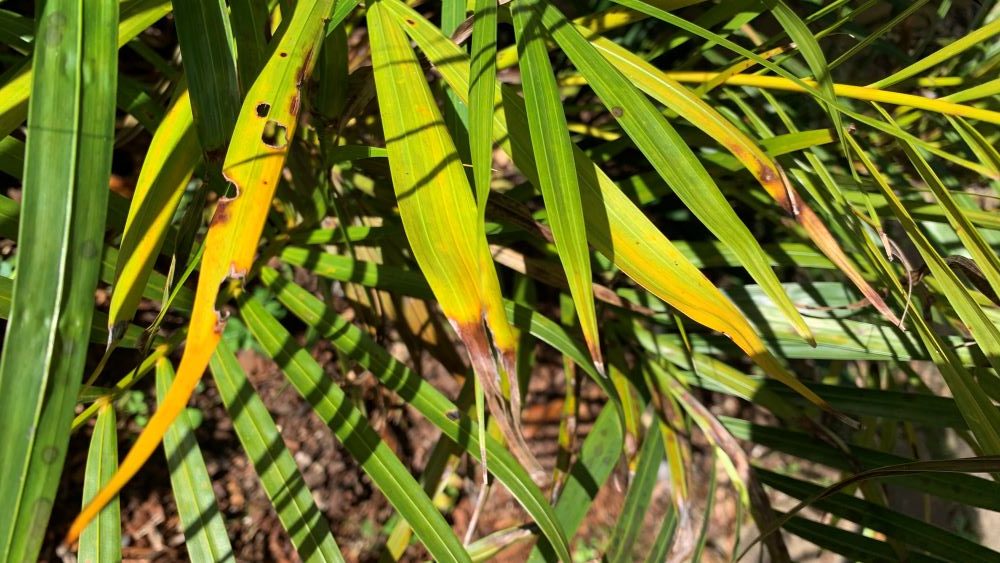
Avoid overwatering outdoor palms by only watering them when the soil starts to fee dry 2 inches down. Deep water the plant every 2-3 days over summer to keep them happy.
What to do if your outdoor palm has brown leaf tips
Here are a few easy tips to help to tidy up your palm if it has developed brown leaf tips.
1. Trim off old leaves
Use sharp, clean secateurs to remove any old leaves that have turned more than 50% brown. Old leaves will start to turn brown closer to the bottom part of the palm stem. Removing old leaves will allow more sunlight to reach the new leaves and the plant will recover quickly.
2. Surround your outdoor palm with mulch
Surround your outdoor palm with mulch to help to keep water in and avoid heavy rain washing the soil away from the roots. You can use shredded old palm leaves, bark or even straw. This will break down slowly and increase the amount of organic matter in the soil to feed the worms.
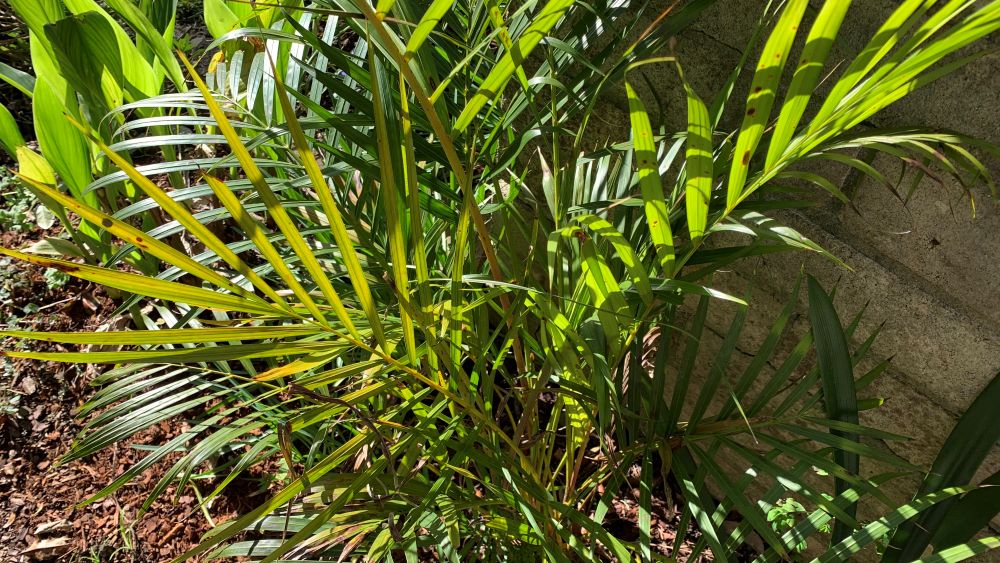
3. Water outdoor palms regularly
Watering outdoor palms regularly particularly in summer is a great way to keep their leaves brown and healthy. Water them deeply every 3-4 days in the hotter months. Decrease your watering over winter to avoid root rot and reduce the chance of brown leaf tips.
4. Use a mild organic fertilizer
Feed your outdoor palms in spring with a gentle organic fertilizer. You can also give them a dose of fish emulsion to encourage better root growth and to improve the soil microbe population.
Brown Tips on Outdoor Palm Leaves | Summary
Outdoor palms can develop brown leaf tips if they are given too much fertilizer and water and not enough sun. If the leaves are yellow they can recover and turn green again if the problem is addressed. You can clean up your palm once the leaf has turned brown by trimming off old leaves. Avoid removing more than 20% of the leaf coverage.
Happy growing.
I am an accredited practicing dietitian, experienced gardener and a dedicated cook. I love writing and sharing my experience so you can learn from my successes and mistakes.
